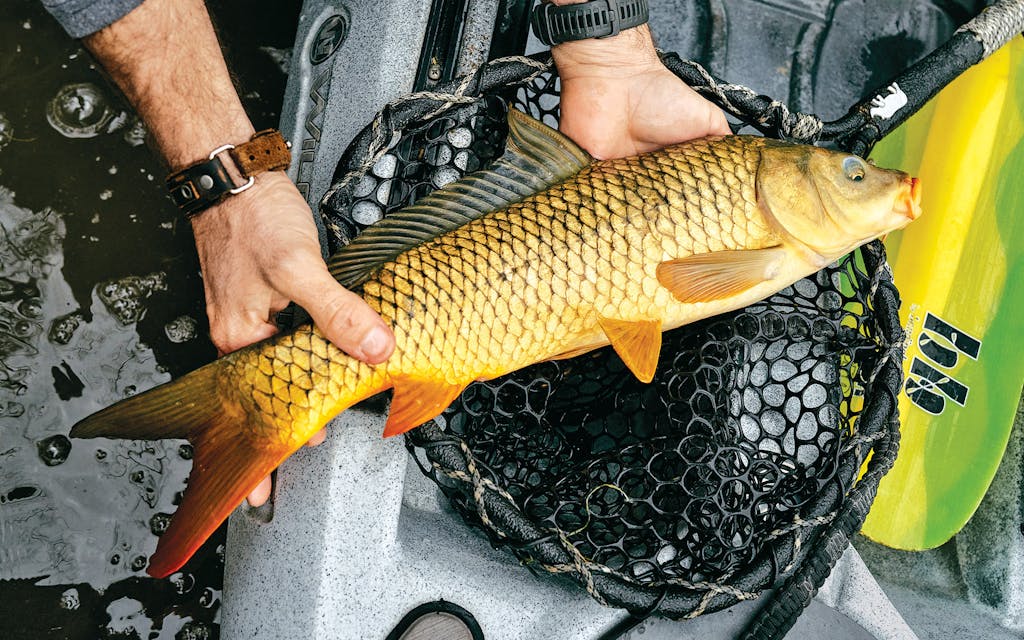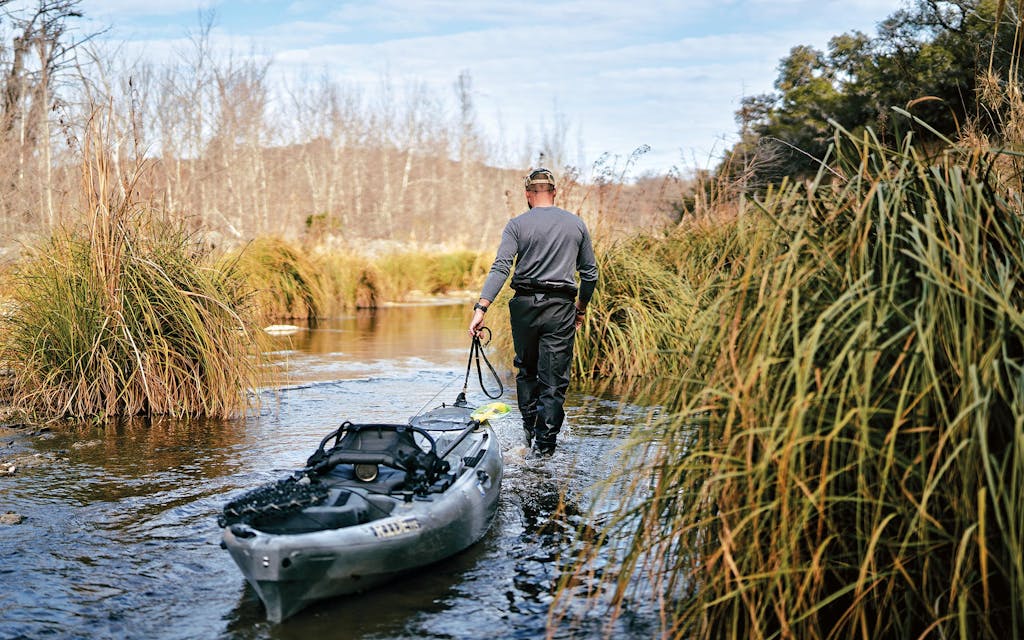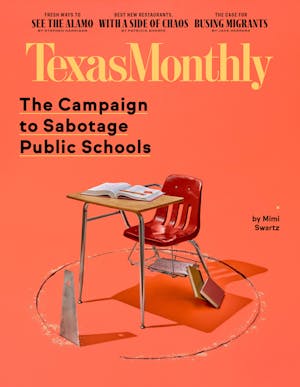I was walking along the banks of a remote stretch of the Pecos River when I spotted something at the water’s edge: a blue plastic box, the size of a small book, out of place in this unpeopled land of rock and cactus. Inside lay a colorful assortment of fishing flies. It was May 2020, and I had been trying to teach myself to fly-fish on the Pecos, where some friends and I own a patch of riverside desert near Langtry, in southwest Texas. I had learned just enough to know that the lures were mostly hand tied, a personal collection curated by an expert. Some angler out there, I thought, must be pretty bummed. I, on the other hand, felt lucky, if a little guilty. Then I flipped the box over and saw a phone number.
“Hi there. I found a box of flies on the Pecos River that I think belongs to you,” I texted when I got back home to Austin. I received a reply five minutes later: “No way! Lost them last week! I’ll pay for shipping and a 6-pack LOL!”
The owner turned out to be a San Marcos man with a very Texan name: John Henry Boatright. He was 36 years old, a chemist, and, as I would learn, one of the most enthusiastic fly anglers for one of the state’s most underappreciated sport fish: the carp. He was also generous: I soon received a gift package that included a set of flies and the just-released Fly Fishing Austin & Central Texas, by Aaron Reed. When I flipped to the chapter on carp, I saw a photo of Boatright crouched in the waters of the Pedernales River as he admired a golden slab of the species.
I looked him up on Instagram and found photos of the bass, carp, and freshwater drum he had caught on the Pecos. Boatright later explained that he and his friends had spent their last night of a seven-day kayaking trip along the river on our land, cozying underneath a large rock overhang. In the morning, he had tied on a tiny carp fly that would go on to catch a six-pound bass and in his haste had forgotten the box. It was serendipity, we decided, that of the 61 miles they paddled, he had left the flies at my place.
Boatright’s affection for carp piqued my interest in the maligned species. Like most American anglers, I had been taught as a kid that carp were “trash fish,” a nasty, inedible invasive species that fouls up the water and crowds out native game fish such as bass and catfish. I recall my dad’s friends leaving carp to rot on the banks of Coleto Creek in South Texas—an act, they thought, of public service. That’s still not an uncommon attitude. Just look at the nicknames that anglers use for carp: “mud marlin,” “ditch tarpon,” and “sewer salmon.” What did an accomplished angler like Boatright see in them? I wondered.
I caught a few bass with the flies he gave me, but I put away my gear once my daughter was born. Time was suddenly at a premium, and midlife hobbies would have to wait. I lost touch with my new friend. Then, last summer, I noticed that carp were enjoying a renaissance among some anglers. I texted Boatright: “Remember me?”
A few months later, on an October afternoon, Boatright and I stood in the spot where he lost his fly box, gazing into the swift aquamarine waters of the Pecos. If serendipity had brought the flies back to Boatright, perhaps it would also bring a carp or two to our hooks. Over a few days, I would come to learn how naive that was.
Boatright had tried to prepare me for the challenge. “Carp are likely the toughest fish you’ll target in Texas in many respects,” he had warned in an email. “Carp are wary of movement, sensitive to percussive sound, and finicky.” Like most fly anglers going after this species in the state, Boatright prefers sight casting in clear streams, which presents a dilemma: you can easily see the fish, but they can also see you. The Pecos is particularly maddening in this respect. The water is shallow and clear, and the carp are large. From near the top of the canyon at our place, some 150 feet above the river, I’ve often seen pods of them cruising in a foot of water, like submarines in a kiddie pool.
Unlike with, say, bass fishing, there is no point in blindly casting to a promising stump or a fishy-looking rock. You must put the fly about one to two feet in front of the carp’s path, making an accurate cast so that the fish and the fly meet, as if by chance. The reward is an explosive hookup, which Boatright compares to “lassoing an aquatic bronco.” Among aficionados, the catch is known as the “golden bone”—a favorable comparison to the bonefish, a tropical and subtropical saltwater species that fly anglers hold in reverence.
As we stalk downriver along the shore of fluted limestone and cane and trickling fern-lined springs, I try to imitate his stealth tactics, more akin to spot-and-stalk bow hunting than any fishing I’ve ever done. We duck down to avoid casting our shadows across the water as Boatright, dressed in natural hues to blend in, tells me that he has observed thirty-pound carp spooked by a vulture’s shadow. We sneak up on fishlike objects to suss out whether they’re piscine or lithic. As we wade, we shuffle along gingerly, using riffles to muffle our steps.

Boatright is on the lookout for carp in their telltale feeding mode, called “tailing” because they’re facedown in the river bottom with their tails up. Anglers have their own word for how they feed: chuffing, whereby they suck in the muck and gravel off the bottom to feel for food such as aquatic plants and mollusks. Tailing carp, like tailing redfish on the coast, are a sight caster’s delight. Over the next day and a half of fishing on the Pecos—covering more than ten miles via foot and boat—we see only a handful of tailers. The first comes not far downstream. Boatright spots it through his polarized sunglasses and springs into position, casting from a kung fu–like crouch. “That’s a really nice carp,” he whispers. The line whistles through the air as he places the fly not far from the feeding fish. He begins stripping line to bring the lure nearer. I ready my iPhone for the money shot. “Really?!” Boatright says; something had spooked the fish.
On the second day, we paddle upstream at least four miles, dragging and carrying our inflatables over rapid after rapid. I’m surprised by how little casting we do. The vast majority of our time is spent staring into the water, looking, looking, looking. Boatright, with his practiced eye and better sunglasses, often sees fish where I see only a black blur—or nothing at all. I lose track of how many times we spot a fish moments before it sees us and bolts.
By late morning, I’ve mostly stopped fishing, unable to juggle the complex physics inherent in making occasional pinpoint fly casts while standing in an inflatable kayak buffeted by wind and current. Meanwhile I’m mesmerized by the sizable catfish and gar and bass we keep cruising over. They seem far less panicky than our carp. In one fish-filled pool, I can no longer contain myself: I make a mediocre cast to a hungry-looking catfish. Soon he’s in my hands for a quick photo.
Other than the catfish and some sunfish, which Boatright jokingly calls “carp blocks,” we come up empty-handed. We see dozens of carp but not a single tailer.
For Boatright, it’s all part of the “insanely difficult” challenge of landing a carp on the fly. He views the challenge, and the immersion in nature, as a form of therapy, a way to develop a virtue he too often lacks in his everyday life. “The Scripture version is, God doesn’t teach you patience by giving you everything you want when you want it.” Carp, he says, instruct more through failure than through success. “I think most carp fly-fishermen, and there’s a few of us who’d call ourselves that, are purely in it for the challenge and, conversely, the fleeting reward.”
Boatright is one of a small but growing number of carp evangelists in Texas. He took up the niche sport around 2017, when, weary of crowds of tubers and anglers on the San Marcos and Guadalupe Rivers, he and his friends began looking for something new. “ ‘What’s the thing we can do to get away from people?’ ” he recalls thinking. “Carp fit the bill.”


The common carp—Cyprinus carpio—is nearly ubiquitous in Texas fresh water. It’s found in the crystalline pools of Hill Country streams and the muddy waters of East Texas. It’s in ponds and lakes and rivers and, yes, ditches. Boatright has fished for carp along the River Walk, in San Antonio, and in Buffalo Bayou, in Houston. The carp’s ability to thrive in oxygen-starved, polluted habitats has contributed to the (mostly false) notion that it’s responsible for poor water quality and troubled native species.
Long a prized game fish and food staple in Asia and Europe, the common carp was brought to America by immigrants with Old World tastes. By the 1870s, after years of heavy harvesting that depleted fish resources, the federal government had established a cultivation program to feed a hungry nation, dispersing fingerlings from coast to coast, including to Texas. In 1881, the state’s first fish hatchery opened at Barton Springs, in Austin—to raise carp. (Perhaps not coincidentally, the adjacent Lady Bird Lake is today a trophy carp fishery, yielding the state record for common carp of 44.25 pounds in 2021.) Soon the newcomers had spread across the U.S. in astonishing numbers. But by the late nineteenth century, Americans came to view them as nuisances and interlopers.
Only recently have anglers and game managers reconsidered the carp, mainly because of European influence. In the U.K., the common carp is as esteemed as the largemouth bass is here—the obsessive focus of armies of trophy-seeking anglers, with the attendant prize-money tournaments, tackle shops, and social media influencers. English anglers debate “boilies”—don’t ask—the way soccer fans argue over flopping fouls. Famous fish get named (“Heather the Leather,” “Mary’s Mate”). Famous fishers get inducted into the Carp Fishing Hall of Fame.
Over the years, European anglers have refined a system known as “Euro style,” whereby they typically fish with bait from the shore using sturdy poles equipped with electronic bite alarms. This approach may feel more intuitive to Texans; it is essentially a more sophisticated version of the old-timers’ method of cane-pole fishing with a corn kernel or ball of dough on the hook. Euro style is also accessible to the novice angler: fishing from the bank is de rigueur—no boat required. In the past twenty years, Euro style has found a toehold in Texas, with a handful of professional guides and an annual tournament, hosted by the American Carp Society each fall in Canton’s Mill Creek Lake, a nutrient-rich reservoir sixty miles east of Dallas that produces lots of big carp.
Many Texas fly-fishers, too, have embraced the carp. But Boatright concedes that it remains a specialized pursuit, with only one hundred to two hundred “hard-core” carp fly anglers in the state. At some of his favorite fishing spots—the upper Pedernales and the Blanco River—he rarely sees another soul. It doesn’t help that the common carp is often confused with silver carp and bighead carp, so-called “Asian carp” species that pose a major threat to ecosystems in the Mississippi River basin. Silver carp, which have been found in northeast Texas, are known for leaping into boats. Texas Parks and Wildlife classifies Cyprinus carpio as a nongame species, so there are no regulations on how or how much it can be harvested. “People will bow hunt them and literally leave a pile of them at the boat ramp, and the game wardens don’t care,” Boatright says. “I’ve heard a game warden say, ‘It’s just carp’—like they don’t have a vital place in the ecosystem now too. They’ve been here for a hundred and fifty years.”
Two weeks after our excursion on the Pecos, determined to land our quarry, Boatright and I meet in Johnson City for breakfast tacos and coffee before driving out to a low-water crossing on the Pedernales River, where we’re greeted by the gobble-gobble of a wild turkey. The roughly three-mile stretch upstream is nicknamed “Carptopia” and “Mecca” by Central Texas anglers. The river here is marked by unusual geology: limestone dikes that run diagonal or even perpendicular to the current, defying the normal logic of a watercourse. Viewed from above, the bands of erosion-resistant rock look like rumble strips or shirred fabric. They form distinct pools, giving anglers an edge in such shallow water: if a carp ambush goes awry and the fish scatter, you can move a short distance to another disconnected pool with the new fish none the wiser.

As we work upstream, Boatright tells me of a famed “mirror”—one of a centuries-old strain of common carp distinguished by mirror-
like scales—that lives in a large pool here. It has been caught only once. “It’s a unicorn,” he says. “If you find it, you’ve gotta try to catch it.” But ol’ mirror is nowhere to be seen today. In fact, the poor water quality in this stretch of the river is making fish-spotting difficult. And there’s speculation as to why: development in the Hill Country is affecting natural resources, with wastewater going into waterways and causing algae blooms, a problem made worse by drought-induced low flows.
By late morning, we’ve hiked and waded three miles upstream, reaching a rocky terminus where a tree-lined creek enters the river. Thanks to a few small springs, the water here is unusually clear. Behind a ledge, Boatright spots a carp sitting motionless and facing upstream. At first he makes short casts, putting the fly in front of its snout. Nothing. Then he switches flies, wades into the water, and begins dapping—a technique that involves using the rod tip and a few feet of line to practically bonk the fish on the head with the lure. I imagine a photo of a smiling Boatright holding a fat carp—the perfect tidy ending.
“Something’s up with this one,” Boatright says. “I can even drape my fly across his back, and he doesn’t move.” Boatright shuffles right up to his quarry, reaches into the water, and gives the carp a tickle. The fish eventually scoots off.
That’s the closest we’ll come to a catch all day. Boatright teases me that I’m bad luck, which stung a little bit more a few months later when he landed a carp for a Texas Monthly photographer. He quips that perhaps fly-fishing for carp will be the “twenty-first-century version of snipe hunting”—the practical joke that sends a newbie hunter on a fruitless quest. He quotes an adage, often attributed to Thoreau: “Many go fishing all their lives without knowing that it is not fish they are after.” This seems to me a proper way to think about serendipity: it comes easiest to those who recognize it. And perhaps that’s how the common carp finds its place among the pantheon of game fish: as a fish most of us didn’t know we were looking for.
This article originally appeared in the March 2023 issue of Texas Monthly with the headline “My Quest to Lasso an Aquatic Bronco.” Subscribe today.
- More About:
- Hunting & Fishing
- Fishing









